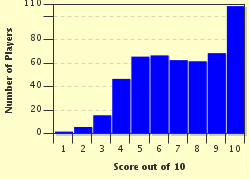Quiz Answer Key and Fun Facts
1. "I, Claudius" starts with the title character calling out his full name. Tiberius Claudius Drusus Nero Germanicus This-that-and-the-other acts as the first person, but of course it was not Claudius who had this autobiography published in 1934. Who was the true author of this novel and of its sequel "Claudius the God"?
2. Tolstoy's novel "War and Peace" is set against the Napoleonic wars. Which of the following characters is one of the protagonists in "War and Peace"?
3. In "Pillars of the Earth" by Ken Follett, the protagonist is Tom Builder. What is the magnum opus Tom Builder wants to realise?
4. "For Whom the Bell Tolls" is a novel set in Spain, during the Spanish Civil War (1936-1939). Which American journalist authored "For Whom the Bell Tolls"? He also left us a novel based upon his experiences during the First World War, when he drove ambulances in Italy.
5. James Clavell wrote several novels set in various epochs in Asia. Which of the following novels is set in Japan around 1600, the dawn of the Edo period?
6. The Australian author Colleen McCullough dedicated a series of seven books to the last century of the Roman Republic. The first book, "The First Man in Rome", concentrates on the decade 110-100 BC, and it sketches the rise of a plebeian to his sixth consulate - something never heard of, for normally one could only be appointed as consul once in a lifetime. Who was this first person to concatenate six consulates?
7. In Umberto Eco's "The Name of the Rose", a British friar travels to an Italian monastery where several monks die under suspicious circumstances. What is the name of the friar who finally unravels several mysteries?
8. Sarah Dunant refers in her first historic novel "The Birth of Venus" of course to the famous painting by Sandro Botticelli. Dunant describes the relationship of a young model and her painter, and uses the historic setting to unravel several murders. Where does the action take place?
9. Time for a French historic novel. Emile Zola left us a novel in which he described a coalminers' strike in the north of France. What is the title of this book?
10. One of the most striking novels on the trench war, was "Im Westen Nichts Neues" - translated into English as "All Quiet on the Western Front". Who was the author?
Source: Author
JanIQ
This quiz was reviewed by FunTrivia editor
agony before going online.
Any errors found in FunTrivia content are routinely corrected through our feedback system.

